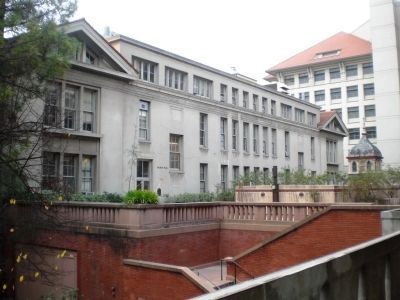Berkeley in Alameda County, California — The American West (Pacific Coastal)
Gilman Hall
University of California
— Berkeley, California, 1916-1917 —
Erected 1997 by American Chemical Society.
Topics. This historical marker is listed in these topic lists: Education • Science & Medicine. A significant historical date for this entry is November 20, 1669.
Location. 37° 52.35′ N, 122° 15.368′ W. Marker is in Berkeley, California, in Alameda County. Gilman Hall is located on the east side of the Berkeley Campus. Driving is not recommended due to the difficulty in parking. Perhaps the easiest way to find Gilman Hall is to enter through the campus' East Gate (off of Gayley Road), and proceed down University Drive to the Hearst Mining Circle. A group of chemistry buildings will be on the left. Proceed between Tan and Campbell Halls, and Gilman Hall will be the second building on the left. Touch for map. Marker is in this post office area: Berkeley CA 94720, United States of America. Touch for directions.
Other nearby markers. At least 8 other markers are within walking distance of this marker. Ernest V. Cowell Memorial Hospital (about 600 feet away, measured in a direct line); University of California Berkeley Campus (about 700 feet away); John Fitzgerald Kennedy Charter Day Speech (approx. ¼ mile away); Cloyne Court Hotel (approx. ¼ mile away); Observatory Hill (approx. ¼ mile away); Fred Turner Building (approx. ¼ mile away); Piedmont Way (approx. 0.3 miles away); Ten Speed Press (approx. 0.3 miles away). Touch for a list and map of all markers in Berkeley.
More about this marker. The marker is to on the right side of the door on the eastern (back) side of the building on the upper plaza level.
Regarding Gilman Hall. Designed by John Galen Howard, Gilman Hall was named in honor of Daniel Coit Gilman, President of the University of California, 1872-1875. Gilman Hall is a National Historic Chemical Landmark. The building is best known for Room 307, the room in which Glenn Seaborg and his colleagues identified plutonium in 1941. The room was declared a National Historic Landmark in 1966. The building currently houses the Department of Chemical Engineering.
Also see . . .
1. U.C. Berkeley Campus Map. Map to aid in finding Gilman Hall. (Submitted on February 4, 2009.)
2. Gilman Hall. Wikipedia entry (Submitted on February 4, 2009.)
3. Gilman Hall, University of California. National Park Service Article on Room 307 provides a more extended history of Room 307 and its role in World War II. (Submitted on February 4, 2009.)
4. Gilman Hall on the UC Berkeley campus is now an official National Historic Chemical Landmark. The U.C. Berkeley Public Information Office press release of 11/21/97 detailing the naming of Gilman Hall as a National Historic Chemical Landmark. (Submitted on February 4, 2009.)
Additional keywords. Plutonium; Manhattan Project
Credits. This page was last revised on January 29, 2023. It was originally submitted on February 4, 2009, by Andrew Ruppenstein of Lamorinda, California. This page has been viewed 2,402 times since then and 53 times this year. Photos: 1, 2. submitted on February 4, 2009, by Andrew Ruppenstein of Lamorinda, California. • Kevin W. was the editor who published this page.

